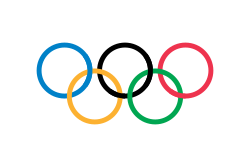Egypten i olympiska sommarspelen 1972
| |||||
| Kommitté | Egyptens Olympiska Kommitté | ||||
|---|---|---|---|---|---|
| Olympiska sommarspelen 1972 i München | |||||
| Deltagare | 23 deltagare i 5 grenar | ||||
| Fanbärare | Kamal Kamel Mohammed | ||||
| |||||
| |||||
| Egypten i olympiska sommarspelen | |||||
| 1896-1908 • 1912 • 1920 • 1924 • 1928 • 1932 • 1936 • 1948 • 1952 • 1956 • 1960 • 1964 • 1968 • 1972 • 1976 • 1980 • 1984 • 1988 • 1992 • 1996 • 2000 • 2004 • 2008 • 2012 • 2016 • 2020 | |||||
| Egypten i olympiska vinterspelen | |||||
| 1924-1980 • 1984 • 1988-2022 | |||||
| Egypten i andra olympiska spel | |||||
| 1906 | |||||
Egypten deltog i de olympiska sommarspelen 1972 med en trupp bestående av 23 deltagare, samtliga män, vilka deltog i 16 tävlingar i fem sporter. Ingen av landets deltagare tog några medaljer.[1]
Basket
- Laguppställning[2]:
Sherif Fouad Aboulkheir
Ahmed Abdel Hamid El-Saharty
Awad Abdel Nabi
Sayed Tewfik El-Sayed
Adel Ibrahim Ismail
Fahti Mohamed Kamel
Mohamed Essam Khaled
Kamal Kamel Mohammed
Talaat Guenidi
Ismail Selim Mohamed
El-Sayed Abdel Hamid Mobarak
- Gruppspel:[3]
| Lag | S | V | O | F | GM | IM | MS | P |
|---|---|---|---|---|---|---|---|---|
| 7 | 7 | 0 | 0 | 542 | 312 | +230 | 14 | |
| 7 | 6 | 0 | 1 | 560 | 445 | +115 | 12 | |
| 7 | 4 | 0 | 3 | 561 | 490 | +71 | 8 | |
| 7 | 4 | 0 | 3 | 493 | 489 | +4 | 8 | |
| 7 | 3 | 0 | 4 | 486 | 500 | −14 | 6 | |
| 7 | 3 | 0 | 4 | 523 | 524 | −1 | 6 | |
| 7 | 1 | 0 | 6 | 442 | 643 | −201 | 2 | |
| 7 | 0 | 0 | 7 | 440 | 644 | −204 | 0 |
Boxning
Brottning
Friidrott
Herrarnas 10 000 meter
- Abdel Hamid Khamis
- Heat — 30:19,2 (→ gick inte vidare)
Simning
| Idrottare | Gren | Heat | Semifinal | Final | |||
|---|---|---|---|---|---|---|---|
| Resultat | Placering | Resultat | Placering | Resultat | Placering | ||
| Kamal Kenawi Ali Moustafa | 200 m frisim | 2:05.30 | 5 | i.u. | Gick inte vidare | ||
| 400 m frisim | 4:24.97 | 7 | i.u. | Gick inte vidare | |||
| 1500 m frisim | 17:40.37 | 6 | i.u. | Gick inte vidare | |||
| Amin Ahmed Adel Youssef | 100 m ryggsim | 1:04.40 | 6 | Gick inte vidare | |||
| 200 m medley | 2:24.61 | 6 | i.u. | Gick inte vidare | |||
Källor
- ^ Egypt at the 1972 München Summer Games Arkiverad 31 december 2008 hämtat från the Wayback Machine.. Sports Reference. Läst 10 januari 2016.
- ^ Egypt Basketball at the 1972 München Summer Games Arkiverad 2 januari 2009 hämtat från the Wayback Machine.. Sports Reference. Läst 10 januari 2016.
- ^ Basketball at the 1972 München Summer Games: Men's Basketball Preliminary Round Arkiverad 6 mars 2016 hämtat från the Wayback Machine.. Sports Reference. Läst 10 januari 2016.
| ||||||||||
Media som används på denna webbplats
Författare/Upphovsman: SanchoPanzaXXI, Licens: CC BY-SA 4.0
Flag of Spain during the Spanish State. It was adopted on 11 October 1945 with Reglamento de Banderas Insignias y Distintivos (Flags, Ensigns and Coats of Arms Bill)
Variant version of a flag of Japan, used between January 27, 1870 and August 13, 1999 (aspect ratio 7:10).
Variant version of a flag of Japan, used between January 27, 1870 and August 13, 1999 (aspect ratio 7:10).
Olympic Movement flag
Proportions 2:3, created 1913, adopted 1914, first used 1920.
- Colors as per http://fairspielen.de/wp-content/uploads/2015/09/Annexe-3-Olympism_and_the_Olympic_Symbol_-_Principles_and_Usages_Guide-1.pdf
- blue: PMS 3005C
- yellow: PMS 137C
- black: PMS 426C
- green: PMS 355C
- red: PMS 192C
- Dimensions of the rings taken from http://fairspielen.de/wp-content/uploads/2015/09/Annexe-3-Olympism_and_the_Olympic_Symbol_-_Principles_and_Usages_Guide-1.pdf
The flag of Brazil from 1968 to 1992 with 23 stars.
The Egyptian flag (1972-1984). Also the flag of Libya (1972-1977) and Syria (1972-1980), when the three countries formed the nominal “Federation of Arab Republics”. (For a map of the federation, see Image:Esl.PNG.)
The Arab text in the scroll held by the “Golden Hawk of Qureish” reads Arabic اتحاد الجمهوريات العربية, ittiħād al-jumhūriyyāt al-`arabiyya, i.e. the Federation (literally “Union”) of Arab Republics — in a quasi-Kufic script (in its original form, with a very ornamental letter dal د).









